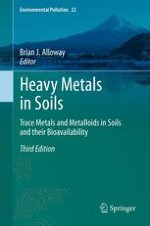2013 | OriginalPaper | Buchkapitel
17. Zinc
verfasst von : Jelle Mertens, Erik Smolders
Erschienen in: Heavy Metals in Soils
Verlag: Springer Netherlands
Aktivieren Sie unsere intelligente Suche, um passende Fachinhalte oder Patente zu finden.
Wählen Sie Textabschnitte aus um mit Künstlicher Intelligenz passenden Patente zu finden. powered by
Markieren Sie Textabschnitte, um KI-gestützt weitere passende Inhalte zu finden. powered by
